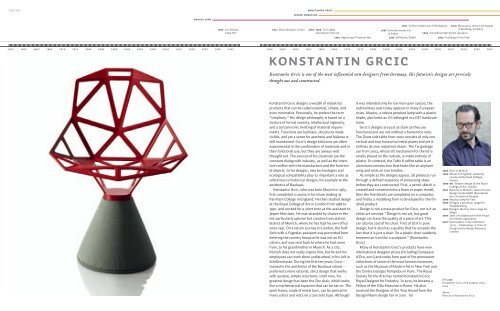farbe wird noch festgelegt
farbe wird noch festgelegt
farbe wird noch festgelegt
You also want an ePaper? Increase the reach of your titles
YUMPU automatically turns print PDFs into web optimized ePapers that Google loves.
130| 131Donald JuddJasper MorrisonKonstantin Grcic1930 Luis Buñuel,L’Age d’Or1941 Bruce Nauman is born 1955–1968 Civil rightsmovement in the US1965 Beginning of Vietnam War1991 Conflict breaks out in the Balkans 2010 Mass panic at the Love Paradein Duisburg, Germany1983 Civil war breaks outin Sudan1999 Columbine High School massacre1986 Jeff Koons, Rabbit2005 Founding of YouTubeKonstantin Grcic1850 1855 1860 1865 1870 1875 1880 1885 1890 1895 1900 1905 1910 1915 1920 1925 1930 1935 1940 1945 1950 1955 1960 1965 1970 1975 1980 1985 1990 1995 2000 2005 2010 2015 2020 2025Konstantin Grcic is one of the most influential new designers from Germany. His futuristic designs are preciselythought out and constructed.Konstantin Grcic designs a wealth of industrialproducts that can be called essential, simple, andeven minimalist. Personally, he prefers the term“simplicity.” His design philosophy is based on amixture of formal severity, intellectual ingenuity,and a certain ironic twisting of material requirements.Functions are laid bare, structures madevisible, and yet a sense for aesthetic and balance isstill maintained. Grcic’s design solutions are oftenexperimental in the combination of materials and intheir functional use, but they are always wellthought out. The sources of his creativity are theconstant dialog with industry, as well as the intensiveconflict with the manufacture and the functionof objects. In his designs, new technologies andecological compatibility play as important a role asreferences to historical designs, for example to theaesthetics of Bauhaus.Konstantic Grcic, who was born Munich in 1965,first completed a course in furniture making atParnham College in England. He then studied designat the Royal College of Art in London from 1988 to1990, and worked for a short time as the assistant toJasper Morrison. He was stranded by chance in thenot particularly uptown but creative train stationdistrict of Munich, where he has had his own officesince 1991. On a return journey to London, the half-Serb with a Yugoslav passport was prevented fromentering the country because he was not an EUcitizen, and was sent back to where he had comefrom, to his grandmother in Munich. As a city,Munich does not really inspire him, but he and hisemployees can work there undisturbed, in his loft inSchillerstrasse. During the first ten years, Grcic –trained in the aesthetics of the Bauhaus school –preferred a more rational, strict design that workswith austere, simple structures. Until now, hisgreatest design has been the One chair, which lookslike a mathematical equation that can be sat on. Theopen frame, made of metal bars, can be painted inmany colors and rests on a concrete base. Althoughit was intended only for German open spaces, therudimentary seat today appears in many Europeancities. Mayday, a robust pendant lamp with a plasticshade, also looks as if it belonged in a DIY hardwarestore.Grcic’s designs are just as stark as they arefunctional and are not without a humoristic note.The Diana side table from 2002 consists of only onevertical and two horizontal metal plates and yet itstill has its own industrial charm. The Tip garbagecan from 2003, whose lift mechanism for the lid issimply placed on the outside, is made entirely ofplastic. In contrast, the Table B coffee table is analuminum construction that looks like an airplanewing and rests on two trestles.As simple as the designs appear, all products runthrough a defined sequence of processing stepsbefore they are constructed. First, a pencil sketch iscreated and converted into a foam or paper model,then the fine details are completed on a computer,and finally a modelling form is developed for the finishedproduct.Design is not a mass product for Grcic, nor is it anelitist art concept. “Design is not art, but gooddesign can have the quality of a piece of art. Thiscan also be said of his chair. First of all it is puredesign, but it also has a quality that far exceeds thefact that it is just a chair. So a plastic chair suddenlybecomes an icon like a sculpture.” (KonstantinGrcic)Many of Konstantin Grcic’s products have woninternational designer prizes (including Compassod’Oro, 2001) and today form part of the permanentcollections of some of the most famous museums,such as the Museum of Modern Art in New York andthe Centre Georges Pompidou in Paris. The RoyalSociety for the Arts has named Konstantin GrcicRoyal Designer for Industry. In 2010, he became aFellow of the Villa Massimo in Rome. He alsoreceived the Designer of the Year Award from theDesign Miami design fair in 2010. hd1965 Born in Munich1985 Moves to England; carpentrycourse at Parnham College,Dorset1988–90 Studies design at the RoyalCollege of Art, London1991 Returns to Munich; opens his owndesign studio KGID (KonstantinGrcic Industrial Design)1998 Mayday lamp for Flos1999 Designs a porcelain range forNymphenburg2003 Designs the One chair range forMagis2004 Start of collaboration with Krupsfor kitchen appliances2007 Participates in the exhibition25/25 – Celebrating 25 Years ofDesign at the Design Museum,Londonleft pageKonstantin Grcic, One outdoor chair,2004abovePortrait of Konstantin Grcic


